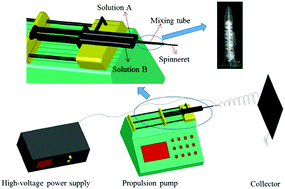Solvent-free two-component electrospinning of ultrafine polymer fibers
Abstract
Solvent recovery is a big challenge in conventional solution electrospinning for the large-scale production of ultrafine fibers because the precursor utilization ratio is usually less than 20 wt%. In this paper, we report an eco-friendly two-component electrospinning technique for the fabrication of acrylate composite fibers using a homemade device at room temperature. During this electrospinning process, the two-component spinning solutions (component A: t-butyl peroxy-2-ethyl hexanoate (BPOEH), isobornyl methacrylate (IBOMA), nitrile rubber (NBR), methacrylic acid (MAA); component B: N,N-dimethylaniline (DMA), IBOMA, NBR and MAA) are nearly all electrospun into ultrafine fibers, and the utilization ratio of the precursor can reach more than 90 wt%. The fiber solidification mechanism can be ascribed to the rapid polymerization of the IBOMA monomer in the presence of free radicals formed by a redox initiation system (BPOEH + DMA), which is different from the solvent evaporation in solution electrospinning or cooling solidification in melt electrospinning. Such a two-component electrospinning technique may stimulate the development of an eco-friendly approach to fabricate composite and functional ultrafine fibers.



 Please wait while we load your content...
Please wait while we load your content...